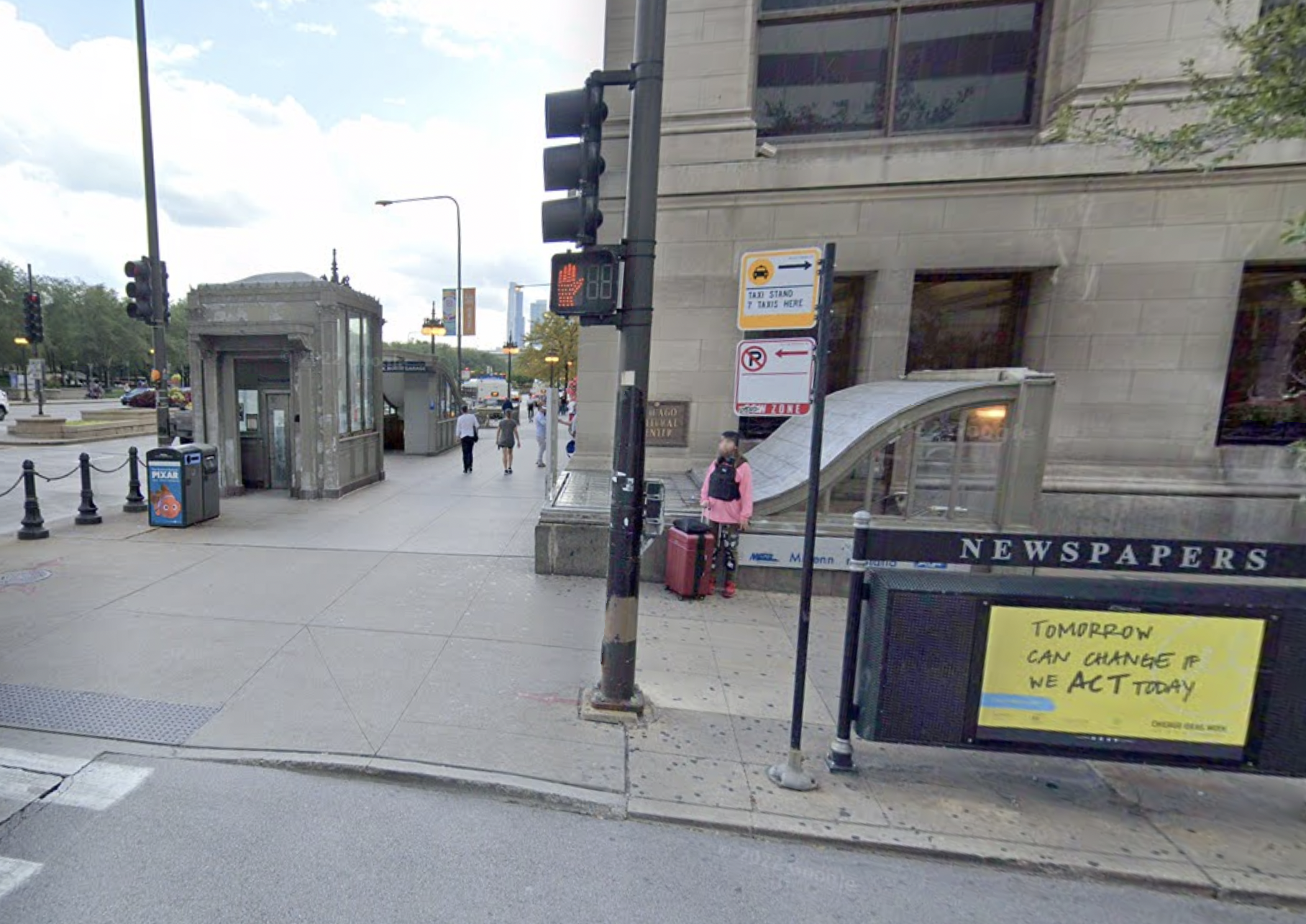
Update 2/15/24, 11:15 AM: According to Metra's "Service Alerts" webpage, the Van Buren Station elevator is also "out of service until further notice."
Update 2/14/24, 3:30 PM: We recently spoke about this issue with Michael Noland, president of the Northern Indiana Commuter Transportation District, which runs the South Shore Line and uses Millennium Station. "I'm looking forward to a resolution of the exact issues that were discussed in your article," he said. "We would all benefit from a functional, dependable elevator, especially those with disabilities."
Noland acknowledged that maintaining repairing the freestanding elevator at Randolph Street and Michigan Avenue is no easy task. "In my next life I'm coming back as an elevator repair person," he said, implying that it's a lucrative profession. "This isn't a quick fix, but this situation has been known about for many years, and the City has been taking decades to repair this properly. It's in a marquis location in Chicago, so it gets lots of use and abuse."
The NICTD president said the challenges of maintaining an outdoor elevator in a northern climate include salt that corrodes the machinery, slush and dirt that gum up the works, and people using transit elevators as a bathroom. (The City of Chicago is trying to address the latter problem by piloting four new public restrooms in the near future.) It doesn't help matters that the Randolph/Michigan lift is a "very old" machine, he said.

Noland indicated that he has empathy for Chicago's struggle to keep this elevator open, since he also has to manage lifts at the South Shore Line's Gary Metro and East Chicago stations. In addition, the upcoming Gateway Station in Hammond will have an elevator to connect the ground-level South Shore Line with the upcoming elevated West Lake Line. (Once the north-south train route opens, the two lines will be rebrandeded the Lake Shore Corridor and the Monon Corridor, respectively, but will still be referred to as parts of the South Shore Line system.)
Still Noland implied that NICTD is losing patience with the Chicago Department of Transportation's lack of communication or action on permanently repairing the Randolph/Michigan elevator. "The City of Chicago should be taking care of its equipment. It needs to be fixed."
By Daniel McNaughton
There's a freestanding elevator at the southwest corner of Randolph Street (130 N.) and Michigan Avenue (100 E.), which provides access to Millennium Station for wheelchair users and others who can't, or prefer not, to use stairs. The lift is "out of service until further notice" according to the Metra "Service Alerts" webpage. That means it's currently a lot more complicated to get to and from Metra Electric District and South Shore Line commuter rail trains without using stairs.
It’s been this way since at least January 12, when I tried to use it while heading to an upright bass gig after riding Metra from my home in Hyde Park to the Loop. Instead of using the Randolph/Michigan elevator, I took the Pedway underground walkway a bit west from Millennium station to the Chicago Cultural Center, where I was able to use its lift to reach street level.
As of January 25 there was a sign posted at street level on the doors of the Randolph/Michigan elevator that simply read, "Elevator Is Temporarily Out of Order."
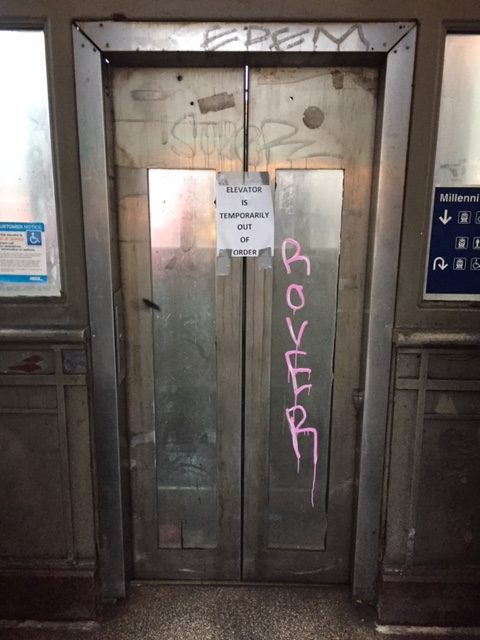
Streetsblog was unable to get info on when the Randolph/Michigan elevator will be fixed. It is owned by the City of Chicago and overseen by the Chicago Department of Transportation, but CDOT spokesperson Erica Schroeder has not responded to multiple emails.
Although Metra doesn't own the Randolph/Michigan elevator, which its customers use to get to MED trains, the railroad says it has been doing its part to try to keep the lift running. "Metra has been maintaining [the Randolph/Michigan elevator] but we now deem it to be beyond repair," spokesperson Michael Gillis said. "We have reached out to the city to meet to further clarify actions and develop a joint plan to improve or replace the elevator."
The elevator in the Chicago Cultural Center, located just west of the broken lift and accessible from Millennium Station via the Pedway, can be used from 10 a.m. to 5 p.m. Another nearby lift that the public can use to move between the Pedway and street level is in at LA Fitness, in the 55 East Randolph Street building, just west of the cultural center. It is generally accessible until 7 p.m.
By February 8, a map of how to find the cultural center's elevator was posted on the doors of the Randolph/Michigan elevator, and the structure housing the elevator. We recently learned that this was not created by Metra or CDOT, but rather the person who runs the ChicagoPedwayMap.com site.
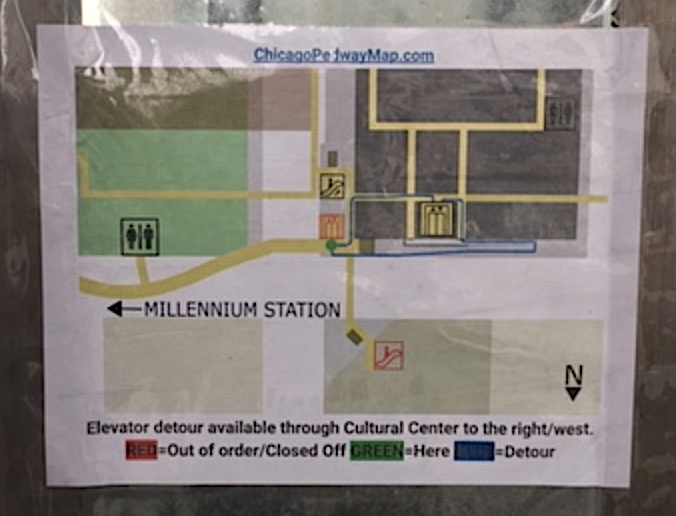
The Metra Service Alerts webpage offers two other alternatives for passengers who need to use an elevator going to or from Millennium Station while the Randolph/Michigan lift is non-functional. But it simply states, "The Millennium Station elevator is out of service until further notice. Customers can use South Water or Van Buren as alternate boarding stations. Updates will be provided."
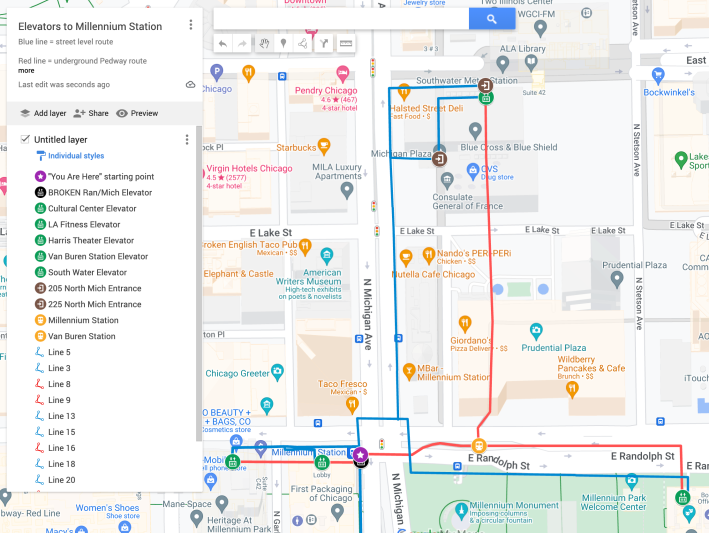
But, frustratingly, Metra provides no details on the Service Alerts website about exactly how people who can't use stairs would access these elevators. So we'll try to explain that.
The "South Water Street" elevator site
Counterintuitively, you don't actually have to travel a full two blocks north of Randolph on Michigan to South Water Street (230 N.) to get to the South Water Street elevator site. But Metra doesn't mention the other option on its Service Alerts webpage.
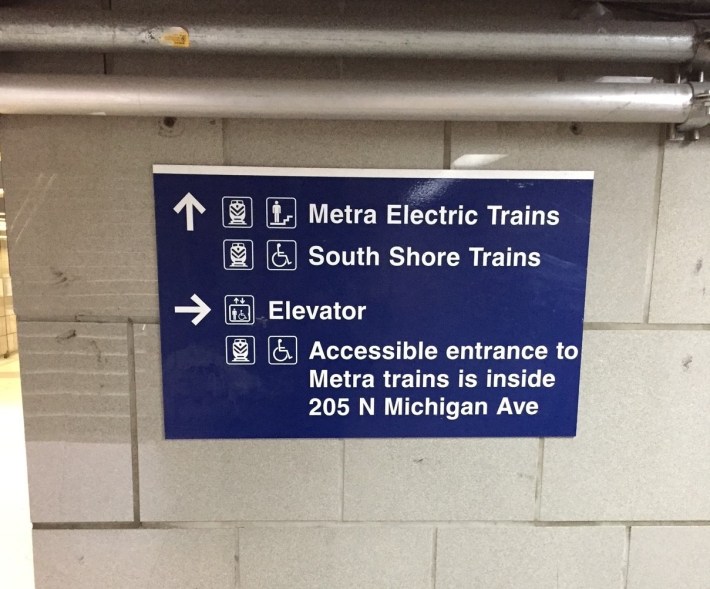
However the Metra "Elevator Sites" web page does say, "South Water Street (accessed through the 205 North Michigan Avenue Building)." That building is only one block north of Randolph, at the northeast corner of Lake Street (200 N.) and Michigan.
But you can also access the elevator from the southeast corner of South Water Street and Michigan Avenue, from the lobby of the 225 North Michigan Avenue building. (Both the 205 and 225 North buildings are part of the Michigan Plaza complex.)
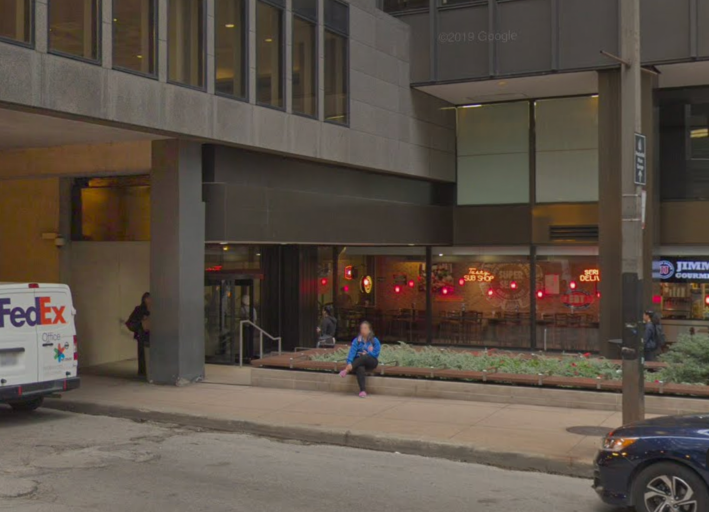
However, accessing the 225 North Michigan entrance on South Water Street without walking down stairs, is a little non-intuitive. Coming from Michigan, instead of heading east on the South Water sidewalk, you must use a walkway located between Sweetwater tavern and the building's pillars. Fortunately there is a sign posted on a pole to direct customers down the walkway, although it's easy to miss.

The 225 North Michigan Avenue entrance is only available on weekdays, opening at 4 a.m. and closing at 9 p.m. The 205 North Michigan Avenue lobby is open 24 hours a day. The 225 entrance is closer to the elevator to Millennium Station, which is located just inside the lobby, but the 205 entrance has an automatic door.
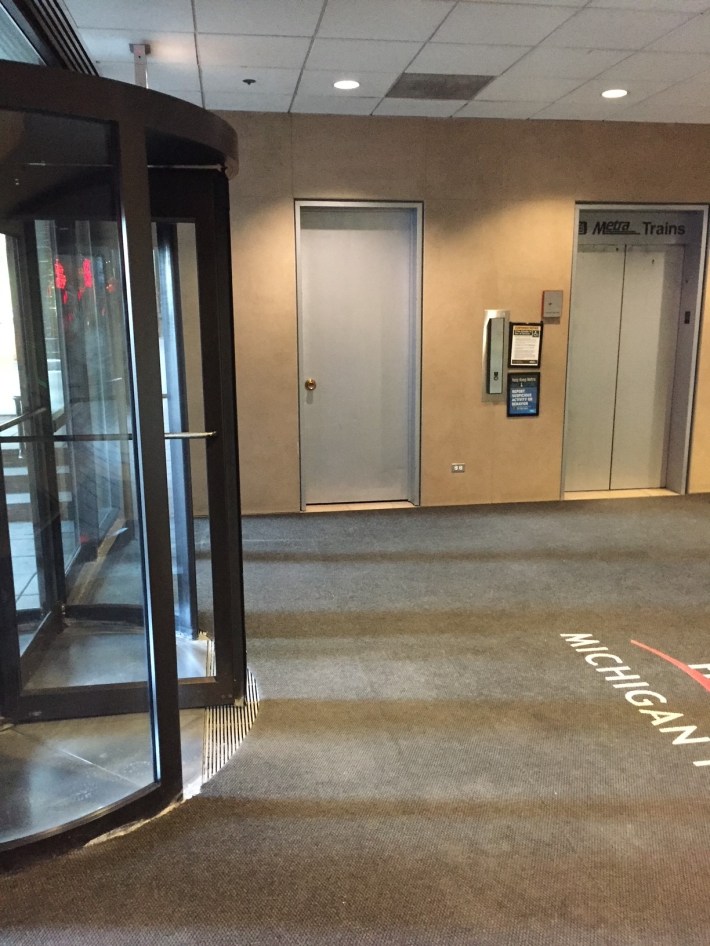
"The only official ADA entrance to [access Metra's MED platform] is inside the building at 205 North Michigan, where the elevator takes customers down to the South Water Street entrance to the platform level of the station," Gillis said. "The doors at the [205 North] entrance to that building are always open. There is not an ADA-accessible route to the platforms from the other elevators [on Randolph] because the ramps that go down from the waiting area to the platform level on that side are too steep to be ADA-compliant."
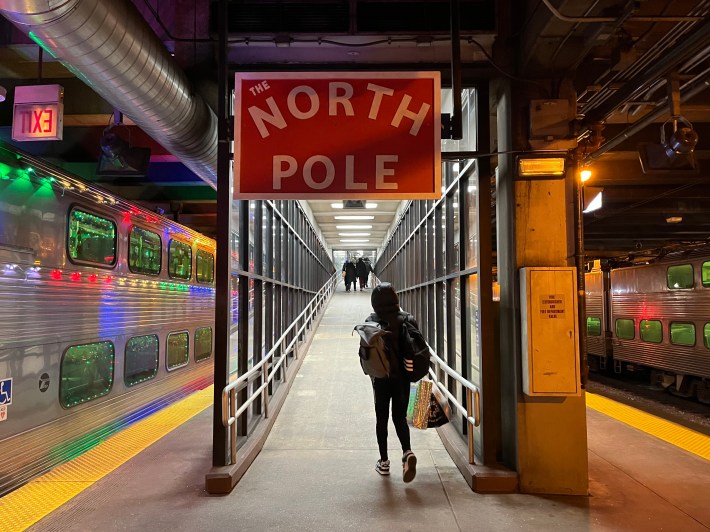
Gillis acknowledged that neither the 225 or 205 North entrances to access the elevator to Millennium Station are easy to find. "We understand this is a problem, and we will be working with the building and with the city to make improvements. We are also working with the [building management] on a planned rehab of the South Water Street entrance."
The Van Buren elevator site
Van Buren Station is six blocks, half a mile, south of Randolph. Compared to the South Water Street elevator, the freestanding Van Buren stop lift is easy to find on the southwest corner of Van Buren Street (400 S.) and Michigan.
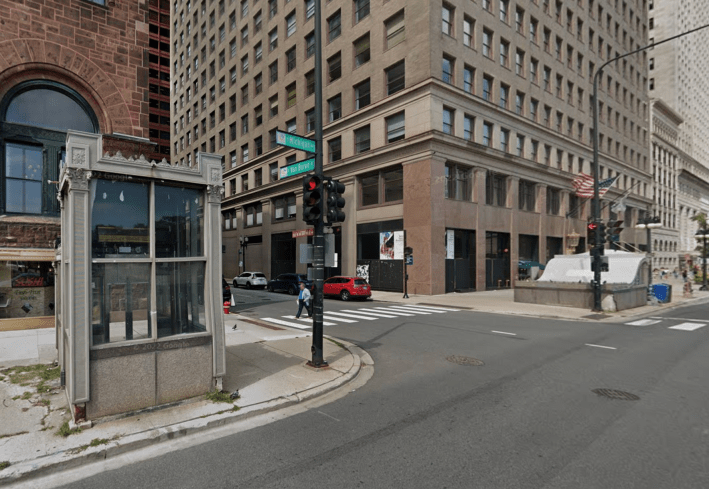
Both Metra Electric District and South Shore Line trains stop at Van Buren while leaving and arriving downtown. But Active Transportation Alliance advocacy manager Julia Gerasimenko argued that the current alternatives while the Randolph/Michigan lift is broken are inadequate for people with disabilities and others who need elevators.
"Millennium Station is a major destination and travel hub for riders coming on the Metra Electric and South Shore lines," Gerasimenko said. "So it's critical that accessibility is prioritized for all customers without the undue burden of being redirected to a less convenient alternative. We are aware that Metra continues to apply for funding with the [Federal Transit Administration's] All Stations Accessibility Program and we have provided various letters of support over the years for such projects."
Unless a passenger checks the Metra website beforehand or talks to an employee, there’s no way to know whether either elevator at Millennium Station (Randolph/Michigan or South Water Street) is working before arriving at the station. There are no signs on the platforms to alert customers so that they won’t make an unnecessary trip.
For passengers arriving at Millennium Station who need an elevator, in addition to the South Water Street elevator, Metra workers have been guiding people to the lift that goes up to the lobby of the Harris Theater, 205 E. Randolph.
People with mobility issues, strollers, or bikes, and anyone else traveling with a substantial piece of equipment (like a string bass!) must pass through two sets of manual doors while using the Randolph/Michigan elevator or the 225 North Michigan entrance, or one manual door while using the 205 North Michigan entrance.
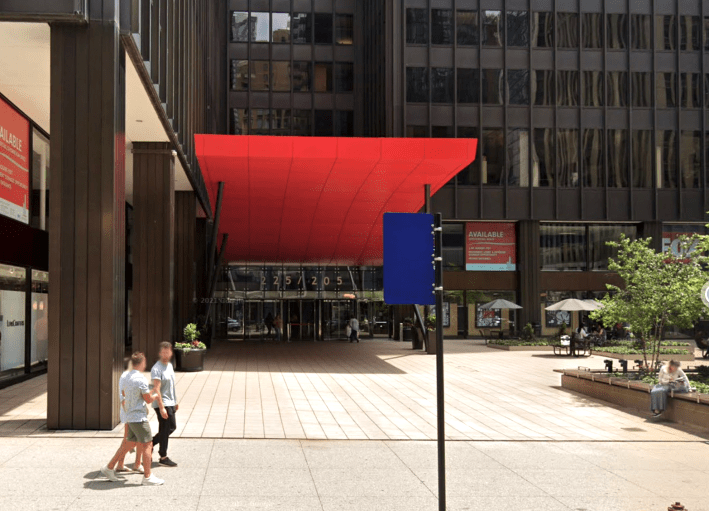
Asked about the possibility of automatic doors’ being installed at these locations, Gillis said, "We have no immediate plans to add [them] at Millennium." The 2010 ADA Standards for Accessible Design do not require automatic doors in transit facilities. While the planned renovation of Van Buren Station does not mention automatic doors, according to Gillis the station will be "fully accessible when complete."
Since May 2022 I’ve regularly used Metra and the 'L' to get to gigs with my double bass. It has opened my eyes to the wide range of transit users who either need accessibility or who benefit from it. Functioning elevators, automatic doors, and clearly visible signs, whether required by law or not, should be a priority for a transit agency that wants to maximize ridership and a city government that wants to ensure all of its citizens can move about the city as easily as possible.

Did you appreciate this post? Please consider making a tax-deductible donation to help Streetsblog Chicago keep publishing through 2025. Thank you.
